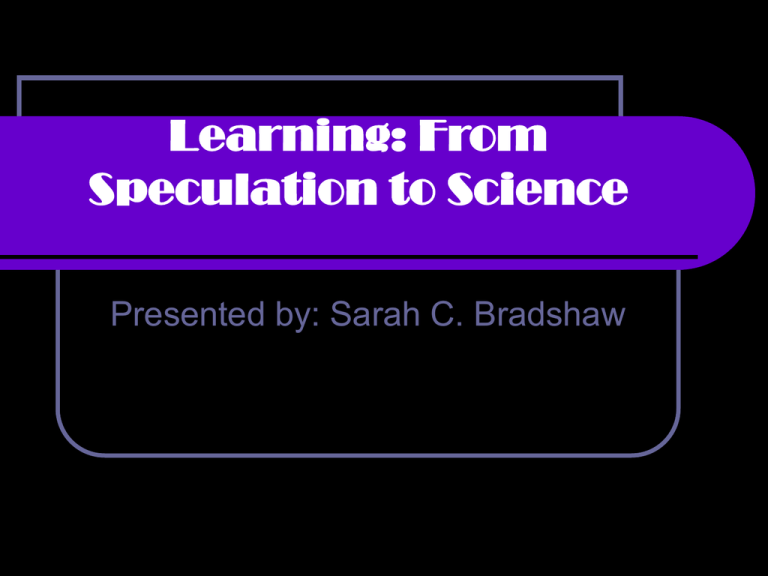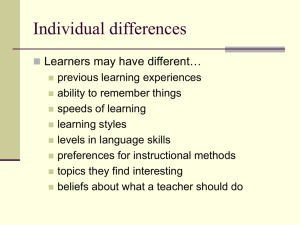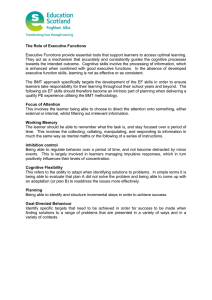Learning: From Speculation to Science Presented by: Sarah C. Bradshaw
advertisement

Learning: From Speculation to Science Presented by: Sarah C. Bradshaw Cognitive science is most simply defined as the scientific study either of mind or of intelligence. http://en.wikipedia.org/wiki/Cognitive_science Cognitive science Our book states that, “The revolution in the study of the mind that has occurred in the last three or four decades has important implications for education.” Cognitive science Also, “Thirty years ago, educators paid little attention to the work of cognitive scientists, and researchers in the nascent field of cognitive science worked far removed from classrooms.” Cognitive science “…education focused on the acquisition of literacy skills: simple reading, writing, and calculating.” Cognitive science “ As Nobel laureate Herbert Simone wisely stated, the meaning of ‘knowing’ has shifted from being able to remember and repeat information to being able to find and use it.” Focus: People, Schools, and the Potential to Learn Three decisions that provided the framework for the study conducted in our book are: First, “we focus primarily on research on human learning (though the study of animal learning provides important collateral information) including new developments from neuroscience.” Second, “we focus especially on learning research that has implications for the design of formal instructional environments, primarily preschools, kindergarten, through high schools (K-12), and colleges.” Third, “and related to the second point, we focus on research that helps explore the possibility of helping all individuals achieve their fullest potential.” Development of the Science of Learning In the beginning of the study of how people learn, scientists “…tried to subject human consciousness to precise analysis-mainly by asking subjects to reflect on their thought processes through introspection.” Behaviorists “Behaviorism is a theory of animal and human learning that only focuses on objectively observable behaviors and discounts mental activities. Behavior theorists define learning as nothing more than the acquisition of new behavior.” http://www.funderstanding.com/behaviorism.cfm Behaviorists Believe, “learning as a process of forming connections between stimuli and responses.” “…such as rewards and punishments.” Edward L. Thorndike The cat had to “learn” to pull a string in order to escape to get the food. “Thorndike concluded that the cats did not think about how to escape and then do it; instead they engaged in trial and error.” Learning with Understanding “…students often have limited opportunities to understand or make sense of topics because many curricula have emphasized memory rather than understanding.” Learning with Understanding “Textbooks are filled with facts that students are expected to memorize, and most tests assess students’ abilities to remember the facts.” United States Map United States Map Constructivists “a philosophy of learning founded on the premise that, by reflecting on our experiences, we construct our own understanding of the world we live in.” http://www.funderstanding.com/constructivism.cfm Constructivists Believe, “ … that all knowledge is constructed from previous knowledge, irrespective of how one is taught.” However, “…teachers should never tell students anything directly but, instead should always allow them to construct knowledge for themselves.” Pre-Existing Knowledge “…teachers need to pay attention to the incomplete understandings, the false beliefs, and the naïve renditions of concepts that learners bring with them…” Pre-Existing Knowledge It is important that teachers “…build on these ideas” to develop a better understanding of the concept. “If students’ initial ideas and beliefs are ignored, the understanding that they develop can be very different from what the teacher intends.” Inquiry-based approach Learning Styles “…individuals perceive and process information in very different ways.” “In fact, educators should not ask, ‘Is this student smart?’ but rather ‘How is this student smart?’” http://www.funderstanding.com/learning_styles.cfm Learning Styles: Visual These learners need to see the teacher's body language and facial expression to fully understand the content of a lesson. They tend to prefer sitting at the front of the classroom to avoid visual obstructions (e.g. people's heads). They may think in pictures and learn best from visual displays including: diagrams, illustrated text books, overhead transparencies, videos, flipcharts and hand-outs. During a lecture or classroom discussion, visual learners often prefer to take detailed notes to absorb the information. http://www.ldpride.net/learningstyles.MI.htm#Learning%20Styles%20Explained Learning Styles: Auditory They learn best through verbal lectures, discussions, talking things through and listening to what others have to say. Auditory learners interpret the underlying meanings of speech through listening to tone of voice, pitch, speed and other nuances. Written information may have little meaning until it is heard. These learners often benefit from reading text aloud and using a tape recorder. http://www.ldpride.net/learningstyles.MI.htm#Learning%20Styles%20Explained Learning Styles: Tactile/Kinesthetic Tactile/Kinesthetic persons learn best through a hands-on approach, actively exploring the physical world around them. They may find it hard to sit still for long periods and may become distracted by their need for activity and exploration. Learning Styles What is your learning style? You will need some kind of scratch paper for this activity http://www.usd.edu/trio/tut/ts/stylest.html Learning Styles Determine which letter you picked the most. More A’s – Visual More B’s – Auditory More C’s - Tactile/Kinesthetic Active Learners “…helping people take control of their own learning.” “…people must learn to recognize when they understand and when they need more information.” Active Learners Metacognition: “people’s abilities to predict their performances on various tasks… and to monitor their current levels of mastery and understanding.” Active Learners “Teaching practices congruent with a metacognitive approach to learning include those that focus on: Sense-making Self-assessment And reflection.” An Evolving Science Our book “synthesizes the scientific basis of learning” by “including a fuller understanding of: Memory and the structure of knowledge Problem solving and reasoning The early foundations of learning Regulatory processes that govern learning How symbolic thinking emerges from the culture and community of the learner.” Key Findings “Students come to the classroom with preconceptions about how the world works. If their initial understanding is not engaged, they may fail to grasp the new concepts and information that are taught, or they may learn them for purposes of a test but revert to their preconceptions outside the classroom” Key Findings “ If children were blank slates, telling them that the earth is round or that one-fourth is greater than one-eighth would be adequate” Key Findings “To develop competence in an area of inquiry, students must: Have a deep foundation of factual knowledge Understand facts and ideas in the context of a conceptual framework, And organize knowledge in ways that facilitate retrieval and application.” Key Findings “…knowledge of a large set of disconnected facts is not sufficient. To develop competence in an area of inquiry, students must have opportunities to learn with understanding. Deep understanding of subject matter transforms factual knowledge into usable knowledge.” Key Findings A “metacognitive” approach to instruction can help students learn to take control of their own learning by defining learning goals and monitoring their progress in achieving them.” Key Findings Students can develop “metacognition” on their own, but strategies of how to have an “internal conversation” with oneself can be taught. Implications for Teaching “Teachers must draw out and work with the preexsting understandings that their students bring with them.” Implications for Teaching “Teachers must teach some subject matter in depth, providing many examples in which the same concept is at work and providing a firm foundation of factual knowledge.” Implications for Teaching “The teaching of metacognition skills should be integrated into the curriculum in a variety of subject areas.” Designing Classroom Environments “Schools and classrooms must be learner centered.” Designing Classroom Environments “To provide a knowledge-centered classroom environment, attention must be given to what is taught, why it is taught, and what competence or mastery looks like.” Designing Classroom Environments “Formative assessments – ongoing assessments designed to make students’ thinking visible to both teachers and students – are essential.” Designing Classroom Environments “Learning is influenced in fundamental ways to by the context in which it takes place.” “A community-centered approach requires the development of norms for the classrooms and school, as well as connections to the outside world, that support core learning values.” Summary “Learning occurs in context: Learning must happen within certain context. Without an appropriate setting, learning is unlikely to succeed.” http://tlt.psu.edu/suggestions/research/How_People_Learn.shtml Summary “Learning is active: "Tell me, I forget. Show me, I remember. Involve me, I understand." This Chinese proverb suggests that learners have to be mentally active during learning activities, make connections between the new knowledge and existing knowledge, and construct meaning from their own experiences.” http://tlt.psu.edu/suggestions/research/How_People_Learn.shtml Summary “Learning is social: Learners benefit from working collaboratively in groups so that they can hear different perspectives and accomplish the learning tasks with the help of their peers and experts.” http://tlt.psu.edu/suggestions/research/How_People_Learn.shtml Summary “Learning is reflective: Learning is facilitated when learners are given chances to express and evaluate on their own thinking.” http://tlt.psu.edu/suggestions/research/How_People_Learn.shtml Informative websites http://tlt.psu.edu/suggestions/research/How_People_Learn.shtml http://www.funderstanding.com/about_learning.cfm Questions?


